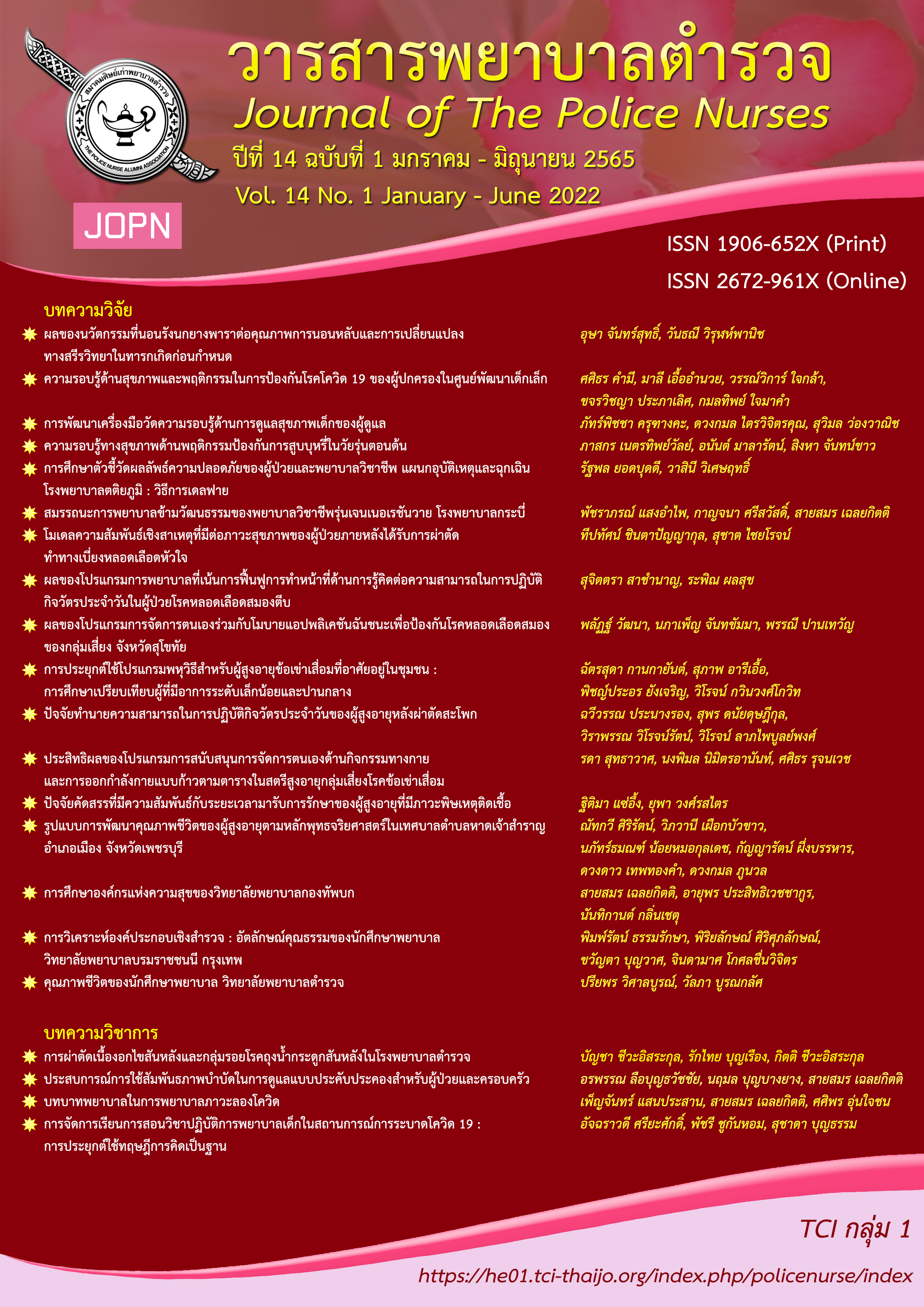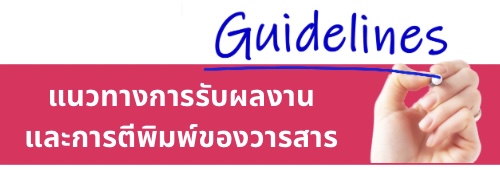การศึกษาตัวชี้วัดผลลัพธ์ความปลอดภัยของผู้ป่วยและพยาบาลวิชาชีพ แผนกอุบัติเหตุและฉุกเฉิน โรงพยาบาลตติยภูมิ : วิธีการเดลฟาย
คำสำคัญ:
ตัวชี้วัดผลลัพธ์, ความปลอดภัยของผู้ป่วย, ความปลอดภัยของพยาบาลวิชาชีพ, แผนกอุบัติเหตุและฉุกเฉินบทคัดย่อ
การวิจัยครั้งนี้เป็นการวิจัยเชิงพรรณนาโดยใช้วิธีวิจัยแบบเดลฟายเพื่อศึกษาตัวชี้วัดผลลัพธ์ความปลอดภัยของผู้ป่วยและพยาบาลวิชาชีพ แผนกอุบัติเหตุและฉุกเฉิน โรงพยาบาลตติยภูมิ ผู้ให้ข้อมูลเป็นผู้เชี่ยวชาญด้านระบบการรักษาพยาบาลฉุกเฉิน การดูแลผู้ป่วยแผนกอุบัติเหตุและฉุกเฉิน โรงพยาบาลตติยภูมิ จำนวน 20 คน คัดเลือกแบบเจาะจงและแบบวิธีบอกต่อ เครื่องมือที่ใช้ในการวิจัย คือ แบบสัมภาษณ์และแบบสอบถาม ซึ่งผ่านการตรวจสอบความตรงโดยผู้เชี่ยวชาญ วิเคราะห์ข้อมูลเชิงคุณภาพโดยใช้การวิเคราะห์เนื้อหา และใช้สถิติบรรยาย ได้แก่ มัธยฐานและพิสัยระหว่างควอไทล์
ผลการวิจัยพบว่า ตัวชี้วัดผลลัพธ์ความปลอดภัยของผู้ป่วย แผนกอุบัติเหตุและฉุกเฉิน โรงพยาบาลตติยภูมิ ประกอบด้วย 7 ด้าน ได้แก่ 1) ความปลอดภัยจากการได้รับการดูแลในภาวะฉุกเฉิน 2) ความปลอดภัยจากการได้รับการดูแลส่งต่อภายนอกโรงพยาบาล 3) ความปลอดภัยจากการได้รับการดูแลส่งต่อภายในโรงพยาบาลและการดูแลรักษาต่อเนื่อง 4) ความปลอดภัยด้านการสื่อสารและสัมพันธภาพกับทีมสุขภาพ 5) ความปลอดภัยด้านการติดเชื้อ
6) ความปลอดภัยด้านสิ่งแวดล้อม 7) ความปลอดภัยด้านการได้รับยาและเลือด โดยมีตัวชี้วัดทั้งหมด 59 ตัวชี้วัด มีค่ามัธยฐานอยู่ในช่วง 3.75 – 4.75 และค่าพิสัยระหว่างควอไทล์อยู่ในช่วง .25 – 2.02 ส่วนตัวชี้วัดผลลัพธ์ความปลอดภัยของพยาบาลวิชาชีพ แผนกอุบัติเหตุและฉุกเฉิน โรงพยาบาลตติยภูมิ ประกอบด้วย 5 ด้าน ได้แก่ 1) ความปลอดภัยด้านสิ่งแวดล้อมในการปฏิบัติงานและการป้องกันความรุนแรง 2) ความปลอดภัยจากการได้รับการดูแลป้องกันการติดเชื้อ 3) ความปลอดภัยจากการได้รับการดูแลในระบบส่งต่อและกฎหมาย 4) ความปลอดภัยจากการได้รับการดูแลด้านสภาพจิตใจ 5) ความปลอดภัยด้านข้อมูลสารสนเทศ รวม 62 ตัวชี้วัด มีค่ามัธยฐานอยู่ในช่วง
4.12 – 4.75 และค่าพิสัยระหว่างควอไทล์อยู่ในช่วง .25 – 1.16
ผลการวิจัยครั้งนี้สามารถใช้กำหนดเป็นแนวทางการประเมินผลลัพธ์เพื่อปรับปรุงกระบวนการดูแลผู้ป่วยให้มีความเหมาะสมและมีประสิทธิภาพ และเป็นแนวทางในการพัฒนาให้เกิดพฤติกรรมความปลอดภัยในการทำงานของพยาบาลวิชาชีพ แผนกอุบัติเหตุและฉุกเฉิน ในโรงพยาบาลระดับตติยภูมิ
Downloads
เอกสารอ้างอิง
Assavanopakun, P., Chaiear, N., & Paileeklee, S. (2020). Appropriate guideline for preventing workplace violence in hospital using a participatory action research. Chiang Mai Medical Journal, 59(2), 65-79.
Bernstein, S. J., & Hilborne, L. H. (1993). Clinical indicators: The road to quality care? The Joint Commission Journal on Quality Improvement, 19(11), 501-509.
Bleier, B. S., Ramanathan Jr., M., & Lane, A. P. (2021). COVID-19 vaccines may not prevent nasal SARS-CoV-2 infection and asymptomatic transmission. Otolaryngology–Head and Neck Surgery, 164(2), 305-307.
Bouillon-Minois, J-B., Raconnat, J., Clinchamps, M., Schmidt, J., & Dutheil, F. (2021). Emergency department and overcrowding during COVID-19 outbreak: A letter to editor. Archives of Academic Emergency Medicine, 9(1). 1-3.
Centers for Disease Control and Prevention. (2016). National hospital ambulatory medical care survey: 2016 emergency department summary tables. Retrieved from https://www.cdc.gov/nchs/data/nhamcs/web_tables/2016_ed_web_tables.pdf
Davis, N. W., Bailey, M., Buchwald, N., Farooqui, A., & Khanna, A. (2021). Factors that influence door-to-needle administration for acute stroke patients in the emergency department. Journal of Neuroscience Nursing, 53(3), 134-139.
Gilboy, N., Tanabe, T., Travers, D., Rosenau, A. M. (2012). Emergency severity index (ESI): A triage tool for emergency department care, version 4. Implementation Handbook, 12-0014.
Gulsen, M. F., KURT, M., Kaleli, I., & Ulasti, A. (2020). Personal protective equipment (PPE) using in Antalya 112 emergency ambulance services during outbreak. medRxiv. Retrieved from https://www.medrxiv.org/content/10.1101/2020.06.16.20129171v2.full.pdf
Information Technology for Emergency Medical System. (2022). Statistics report of emergency medical system. Retrieved from https://ws.niems.go.th/ ITEMS_DWH/
Kraysubun, C. (2018). Guideline for ER service delivery. Department of Medical Services, Ministry of Public Health.
Liu, L-F., Lee, S., Chia, P-F., Chi, S-C., & Yin, Y-C. (2012). Exploring the association between nurse workload and nurse-sensitive patient safety outcome indicators. Journal of Nursing Research, 20(4), 300-309.
Peltan, I. D., Bledsoe, J. R., Oniki, T. A., Sorensen, J., Jephson, A. R., Allen, T. L., & Brown, S. M. (2019). Emergency department crowding is associated with delayed antibiotics for sepsis. Annals of Emergency Medicine, 73(4), 345-355.
Schmitz, D., Vos, M., Stolmeijer, R., Lameijer, H., Schönberger, T., Gaakeer, M. I., de Groot, B., Eikendal, T., Wansink, L., & Ter Avest, E. (2021). Association between personal protective equipment and SARS-CoV-2 infection risk in emergency department healthcare workers. European Journal of Emergency Medicine, 28(3), 202.
Seccia, R. (2020). The nurse rostering problem in COVID-19 emergency scenario. Technical Report. Retrieved from http://www.optimization-online.org/DB_FILE/2020/03/7712.pdf
Siriwat, R., Rojtinnakorn, N., Kamsuk, S., Pokpoonsrap, J., & Chiaranai, C. (2019). Development of a seamless nursing communication model using SBAR techniques during transitional care period emergency nursing division Maharat Nakhon Ratchasima hospital. Journal of Nursing and Health Care, 37(1), 60-69.
Swift, M. D., Breeher, L. E., Tande, A. J., Tommaso, C. P., Hainy, C. M., Chu, H., Murad, M. H., Berbari, E. F., & Virk, A. (2021).
Effectiveness of mRNA COVID-19 vaccines against SARS-CoV-2 infection in a cohort of healthcare personnel. Clinical Infectious Diseases.
The Health Accreditation Institute (Public Organization). (2018). Patient safety goals: SIMPLE Thailand 2018. Nonthaburi.
The Healthcare Accreditation Institute (Public Organization). (2016). Patient and personal safety (2P Safety). Retrieved from https://2psafety.ha.or.th/
Umporm, P., Somsri, P., Daekhunthod, T., Nadsantia, P., & Boonkong, P. (2018). A case management model for acute ischemic stroke patients at emergency department, Sakon Nakhon hospital. Journal of Nursing and Health Care, 36(3), 207-220.
Wachiradilok, P., Sirisamutr, T., Chaiyasit, S., & Sethasathien, A. (2016). A nationwide survey of Thailand emergency departments triage systems. Thai Journal of Nursing Council, 31(2), 96-108.
Wakai, A., O’Sullivan, R., Staunton, P., Walsh, C., Hickey, F., & Plunkett, P. K. (2013). Development of key performance indicators for emergency departments in Ireland using an electronic modified-Delphi consensus approach. European Journal of Emergency Medicine, 20(2), 109-114.
Westphal, M., Wall, M., Corbeil, T., Keller, D. I., Brodmann-Maeder, M., Ehlert, U., Exadaktylos, A., Bingisser, R., & Kleim, B. (2021). Mindfulness predicts less depression, anxiety, and social impairment in emergency care personnel: A longitudinal study. Plos one, 16(12), e0260208.
ดาวน์โหลด
เผยแพร่แล้ว
รูปแบบการอ้างอิง
ฉบับ
ประเภทบทความ
สัญญาอนุญาต
ลิขสิทธิ์ (c) 2022 วารสารพยาบาลตำรวจ

อนุญาตภายใต้เงื่อนไข Creative Commons Attribution-NonCommercial-NoDerivatives 4.0 International License.
ผลงานที่ได้ตีพิมพ์แล้วจะเป็นลิขสิทธิ์ของวารสารพยาบาลตำรวจ















